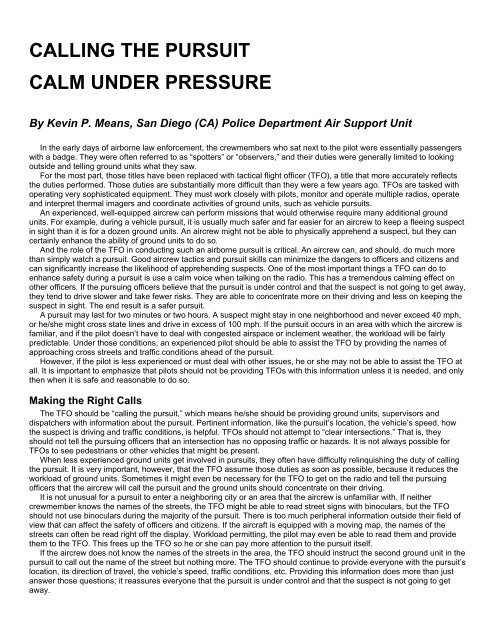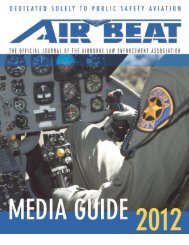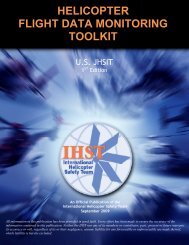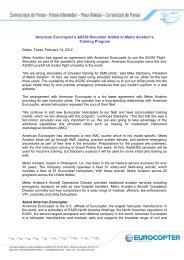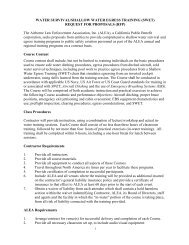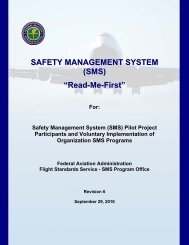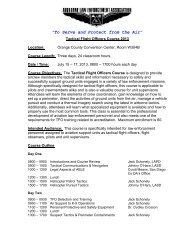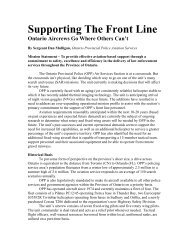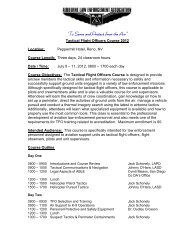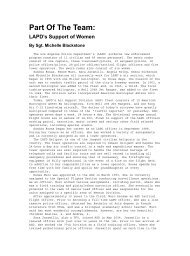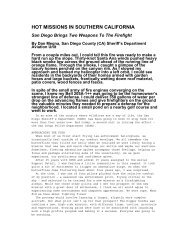Calling The Pursuit - Airborne Law Enforcement Association
Calling The Pursuit - Airborne Law Enforcement Association
Calling The Pursuit - Airborne Law Enforcement Association
Create successful ePaper yourself
Turn your PDF publications into a flip-book with our unique Google optimized e-Paper software.
CALLING THE PURSUIT<br />
CALM UNDER PRESSURE<br />
By Kevin P. Means, San Diego (CA) Police Department Air Support Unit<br />
In the early days of airborne law enforcement, the crewmembers who sat next to the pilot were essentially passengers<br />
with a badge. <strong>The</strong>y were often referred to as “spotters” or “observers,” and their duties were generally limited to looking<br />
outside and telling ground units what they saw.<br />
For the most part, those titles have been replaced with tactical flight officer (TFO), a title that more accurately reflects<br />
the duties performed. Those duties are substantially more difficult than they were a few years ago. TFOs are tasked with<br />
operating very sophisticated equipment. <strong>The</strong>y must work closely with pilots, monitor and operate multiple radios, operate<br />
and interpret thermal imagers and coordinate activities of ground units, such as vehicle pursuits.<br />
An experienced, well-equipped aircrew can perform missions that would otherwise require many additional ground<br />
units. For example, during a vehicle pursuit, it is usually much safer and far easier for an aircrew to keep a fleeing suspect<br />
in sight than it is for a dozen ground units. An aircrew might not be able to physically apprehend a suspect, but they can<br />
certainly enhance the ability of ground units to do so.<br />
And the role of the TFO in conducting such an airborne pursuit is critical. An aircrew can, and should, do much more<br />
than simply watch a pursuit. Good aircrew tactics and pursuit skills can minimize the dangers to officers and citizens and<br />
can significantly increase the likelihood of apprehending suspects. One of the most important things a TFO can do to<br />
enhance safety during a pursuit is use a calm voice when talking on the radio. This has a tremendous calming effect on<br />
other officers. If the pursuing officers believe that the pursuit is under control and that the suspect is not going to get away,<br />
they tend to drive slower and take fewer risks. <strong>The</strong>y are able to concentrate more on their driving and less on keeping the<br />
suspect in sight. <strong>The</strong> end result is a safer pursuit.<br />
A pursuit may last for two minutes or two hours. A suspect might stay in one neighborhood and never exceed 40 mph,<br />
or he/she might cross state lines and drive in excess of 100 mph. If the pursuit occurs in an area with which the aircrew is<br />
familiar, and if the pilot doesn’t have to deal with congested airspace or inclement weather, the workload will be fairly<br />
predictable. Under those conditions, an experienced pilot should be able to assist the TFO by providing the names of<br />
approaching cross streets and traffic conditions ahead of the pursuit.<br />
However, if the pilot is less experienced or must deal with other issues, he or she may not be able to assist the TFO at<br />
all. It is important to emphasize that pilots should not be providing TFOs with this information unless it is needed, and only<br />
then when it is safe and reasonable to do so.<br />
Making the Right Calls<br />
<strong>The</strong> TFO should be “calling the pursuit,” which means he/she should be providing ground units, supervisors and<br />
dispatchers with information about the pursuit. Pertinent information, like the pursuit’s location, the vehicle’s speed, how<br />
the suspect is driving and traffic conditions, is helpful. TFOs should not attempt to “clear intersections.” That is, they<br />
should not tell the pursuing officers that an intersection has no opposing traffic or hazards. It is not always possible for<br />
TFOs to see pedestrians or other vehicles that might be present.<br />
When less experienced ground units get involved in pursuits, they often have difficulty relinquishing the duty of calling<br />
the pursuit. It is very important, however, that the TFO assume those duties as soon as possible, because it reduces the<br />
workload of ground units. Sometimes it might even be necessary for the TFO to get on the radio and tell the pursuing<br />
officers that the aircrew will call the pursuit and the ground units should concentrate on their driving.<br />
It is not unusual for a pursuit to enter a neighboring city or an area that the aircrew is unfamiliar with. If neither<br />
crewmember knows the names of the streets, the TFO might be able to read street signs with binoculars, but the TFO<br />
should not use binoculars during the majority of the pursuit. <strong>The</strong>re is too much peripheral information outside their field of<br />
view that can affect the safety of officers and citizens. If the aircraft is equipped with a moving map, the names of the<br />
streets can often be read right off the display. Workload permitting, the pilot may even be able to read them and provide<br />
them to the TFO. This frees up the TFO so he or she can pay more attention to the pursuit itself.<br />
If the aircrew does not know the names of the streets in the area, the TFO should instruct the second ground unit in the<br />
pursuit to call out the name of the street but nothing more. <strong>The</strong> TFO should continue to provide everyone with the pursuit’s<br />
location, its direction of travel, the vehicle’s speed, traffic conditions, etc. Providing this information does more than just<br />
answer those questions; it reassures everyone that the pursuit is under control and that the suspect is not going to get<br />
away.
If the TFO stops providing that information simply because he or she does not know the names of the streets, the<br />
ground units will start calling the pursuit themselves. <strong>The</strong>y will feel the need to drive faster and take additional risks to<br />
keep the suspect in sight. When TFOs are no longer calling the pursuit and are simply watching or recording it, the safety<br />
benefits of the helicopter are lost.<br />
Editor’s Note: Kevin Means is an ALEA past president and instructor. This article was excerpted from the his book,<br />
“Tactical Helicopter Missions,” which can be purchased on ALEA’s website. Log on to www.alea.org and look under the<br />
merchandise section for details.


